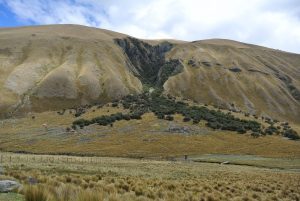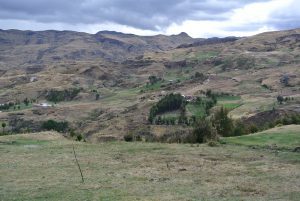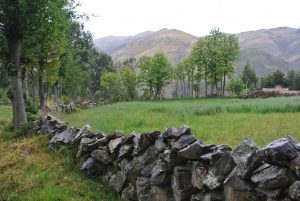
By Cathy Watson, originally published at ICRAF’s Agroforestry World Blog
In Peru, the Andes used to be home to biting poverty but are far more prosperous today. Their indigenous inhabitants benefited from land reform, and successive governments have invested in roads, municipalities and even sports grounds. Nevertheless, there is much to worry about. The environment is profoundly fragile, its degradation threatening economic growth.
Sarah-Lan Mathez-Stiefel from the World Agroforestry Centre (ICRAF) is researching the mountains’ trees. Over half the water in the Amazon watershed comes from Andean forests. But they are fragmented, neglected and a fraction of what they once were. On farms, exotic trees have supplanted native ones.
Coming up: Virtual Symposium on water, climate and forests
In Ancash, Mathez-Stiefel, who is also a Senior Research Scientist at the Centre for Development and Environment (CDE) in Bern, meets experts on social and environmental change. “In Peru we’ve done well on production but less on environment,” says Pedro Estrada, who heads ALLPA, an NGO based in the town of Huari.
Looking across at a group of women in traditional hats and big skirts and at a poster for a bullfight with matadors from Colombia, Estrada says. “It’s striking to see indigenous women eating in restaurants, and twenty years ago, no one would have had ten soles to see a bull fight. Today more money circulates in the economy.”
Other informed commentators also appreciate Peru’s progress but worry deeply about its sustainability. Dr. David Vidal, who directs Peru’s National Research Institute on Glaciers and Mountain Ecosystems, describes how “the glaciers in the Andes have dangerously retreated – 40% since the 1970s”.

Robert Lopez, who is chief of the 340,000 ha Huascaran National Park, is worried that the park’s 41 sub-watersheds are overlooked, especially in light of Peru’s water crisis. “We have to see the park as a water bank that produces water.”
Lopez has just 26 rangers. Yet the park holds most of Peru’s glaciers and lies in the world’s highest tropical mountain chain, the Cordillera Blanca. Rivers that start in the park flow to the Amazon as well as Peru’s hot arid Pacific coast where large farms rely on their water to produce the exports that have helped make Peru a middle income country. Income per person is now $12,000 a year.
The growth of jobs elsewhere in Peru partly explains the threat. “When the park was created in 1975, government gave rights to the people who were using it,” says Lopez. “But they were meant to periodically withdraw to let it recover. This broke down 10-15 years ago. Mining dynamized the economy, pulling men out of cattle. They now just roam, compacting soil and stopping regeneration.”
Glacier expert Dr. Vidal says “In the last 20 years, there has been an abandonment of agriculture towards mining, medium cities, and the coast. In agriculture, you can earn 10-12 soles a day, in mining 40-70. What type of reforestation can we do? Plantations have been planted but we need to think about how to make them deliver more ecosystem services and improve water infiltration.”

Mathez-Stiefel has documented changes in highland villages. One was a vast hacienda 40 years ago with Argentine livestock. Until land reform in the 1970s, its Quechua-speaking inhabitants were serfs who surrendered animals as tithe to the landowner. Transport was by mules, houses were straw, and education took place in a church rather than a school.
Since then, as in most of Peru, where 40% of the population has moved out of poverty since 2000, a great deal has improved. The village now belongs to the community and has houses of cement, potable water, a health center, a kindergarten, primary and secondary school, and electricity. Nationally, 91.4% of dwellings in Peru have electricity, 74.2% in rural areas.
“Some people say land reform was rushed, and there have been attempts to reverse it,” says ALPA’s Estrada, whose grandfather’s own 40 hectares were given to his workers in the reform. “But people are much better off because of it. The system was unjust. There are still communities in the jungle that are made up of people who fled peon status in the Andes.”
However, Mathez-Stiefel has found less positive change – more extreme weather and crop disease, less forest and indigenous tree cover, the virtual disappearance of llamas and other camelids, and depopulation, particularly the flight of men.
Anthropologist Teófilo Altamirano from Peru’s Catholic University calls internal migration “the major transformational force of the past 60 years” in the Andes. Today just 30% of Peruvians live in the mountains, half the figure before. Other ICRAF research has found that about 15% of people in the Amazon are Quechua speakers, a sign of the number of indigenous people that have left the highlands.
Mathez-Stiefel believes trees can address the interlinked challenges of climate, water, energy, diet and livelihoods. “The Andes is dominated by eucalyptus but there is also a rich array of traditional agroforestry practices and indigenous species. One of the most exciting is quenuales, a tree which lives where nothing else lives – up to 15,000 feet.”
“Quenuales (Polylepsis spp.) are uniquely suited to store water in upper basins,” says literature at the Huascaran National Park. “The leaves and bark absorb water, thus creating very humid zones in which there is development of mosses, lichens and fungi. The water absorbed is deposited underground and feeds the region’s ponds. The roots prevent erosion and landslides to lower areas.”
Increasingly aware of its importance, government has begun restoring quenuales. Farmer Margarita Rubina, 42, approves. “It’s a sturdy hedge and protects the house from wind and its branches are good for cooking,” she says. Dressed traditionally, in many ways, she represents the new Andes. Guinea pigs run around her feet on her earth floor. But her children study in schools in town. And where Rubino once had a herd of criollos, descendants of the small stocky cattle brought by the Spaniards 500 years ago, she now has four exotic cows and sells cheese. Mathez-Stiefel and Estrada discuss if planting protein-rich fodder trees might raise her output of milk.
“The rural world has not been seen as an opportunity for life,” says the vet, whose family has been Andean for 300 years. “We need to improve rural identity. Youth do not want to repeat the lives of their parents. But a dignified comfortable life is possible here. Agroforestry is super interesting”
Mathez-Stiefel has work ahead but has clearly found allies.
___ _ _ _ _ _ _ ___
For more about ICRAF’s program in the Andes, contact s.mathez@cgiar.org
Her research to characterize Andean villages was a collaboration between ICRAF and the Andean Forest Program funded by the Swiss Agency for Development and Cooperation (SDC). It forms part of the CGIAR Research Program on Forests, Trees and Agroforestry.











